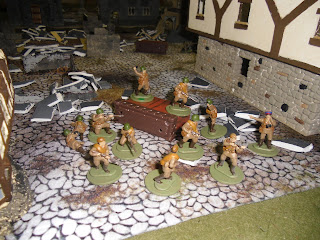Pete and I began the third and final battle in our Bolt Action Russians v Germans series. Each of the battles was planned for two evenings because they are a bit on the large side.This series was a little unusual in that its purpose was to encourage Pete to get his Russians painted. Each of the battles would pit my slightly understrength German infantry company with a few supporting vehicles against as many Russians as Pete could get painted. The downside was Pete had a lot of unpainted stuff which he worked very hard to make table ready.
This last two part battle would feature the German Kampfgruppe Diefenbach defending a ruined town on the road to Berlin against the mad Russian General Pete Behronovich of the 964th Guards Tank Army. General Behrenovich is pretty sure he is attacking Berlin itself (which he expected to be much bigger), but geography was never his strong suit at the Academy.
The sun rose in the East, as it so often does in this part of the world. The Fascists were dug in and well hidden in the town. Behrenovich, ever mindful of his mens welfare, ordered a preparatory bombardment of the town. "Make the rubble bounce" he said (in Russian), and so they did. By the time the firing had stopped they had scared the urine out of the defenders. Pin markers abounded and two of the four defending armored vehicles were immobilized.
While the German defenders picked themselves up and started the process of working off the pin markers Russian infantry cautiously approached the town from the South and Southwest. A firefight broke out between the Russians and the defenders of the municipal building. The Russians committed the bulk of their armor to the fight, sending in six tanks and a tank destroyer. They soon dispatched the enemy Marder and Stug deployed at that end of the town square. A Panzerfaust fired from the building failed to penetrate a Russian tank and a second defender with a Panzerfaust was shot by a tanks hull machine gun before he could launch. A German sniper, in turn, shot the leader of the infantry pressing the attack on the building.
Russian infantry was now moving in on the defenders from all sides. The defenders, now fully recovered from the effects of the bombardment, were holding their fire in their hidden positions, waiting for the Russians to get close enough to engage.
At this point we ran out of time. This battle will be completed next Saturday, and the results, with pictures, posted soon after.

























